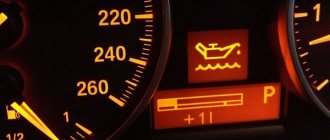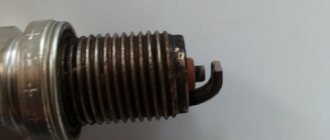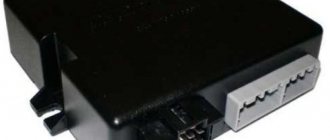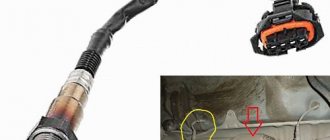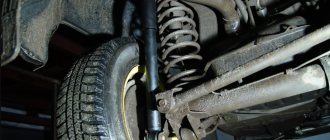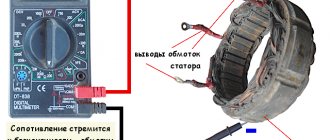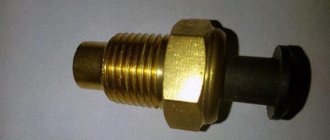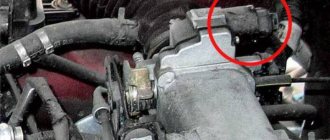29.10.2019
| (Votes: 10, Rating: 4.9) |
Issues discussed in the material:
- What is an ABS light bulb and what is it for?
- Why is the ABS light on?
- Why is the ABS light on and what should you check immediately?
It happens that a suddenly illuminated ABS light makes some motorists shudder nervously. They believe the entire braking system has failed. The puzzled car owner begins to look on the Internet for a way out of this situation. However, there is no need to panic. After all, the brakes may be normal, but malfunctions may occur only in the anti-lock braking system, which is not at all critical. The article discusses in detail the question of why the ABS light is on and what should be done to correct the situation.
What is an ABS light bulb and what is it for?
The ABS system controls the braking of the wheels without locking them. Moreover, the car stops quite quickly. If the car owner is forced to brake sharply, thanks to the anti-lock braking system, loss of control of the car will not occur.
If the vehicle is not equipped with an anti-lock braking system, or it is inoperative, then when braking sharply, the wheels will block or stop rotating. This can lead to the car skidding, which is especially dangerous when turning. If the ABS light is on on the dashboard, this indicates a problem with the anti-lock system. It is very easy to check whether the anti-lock braking system is functioning. To do this, the car is accelerated to a speed of 40 km/h and the brakes are sharply pressed to the floor. If the pedal under your foot does not vibrate, it means that the ABS function is faulty - the indicator lights up. Thanks to the anti-lock braking system, you can suddenly “slam on the brakes” and then quickly go around an obstacle. If there is no ABS function, sharp braking and simultaneous avoidance of obstacles is impossible, since there is a high risk of the vehicle skidding.
The anti-lock braking system consists of the following elements:
- rotation sensors (all wheels of the car are equipped with them);
- hydraulic control unit;
- a special mechanism for monitoring the functions of the hydraulic unit;
- ABS light bulb located on the instrument panel.
Objective reasons why the ABS light may be on are errors on the instrument panel:
- When you start the car engine, all the lights on the dashboard light up, this indicates that the car’s systems are in operating mode. If the automation is fully operational, then within a few minutes all the icons on the display will go out. But when the ABS indicator does not light up when you start the engine, most likely the light bulb is not working.
- A long-burning ABS light indicates a malfunction in the anti-lock braking system. The malfunction is detected by the on-board computer, which recognizes and stores the fault code, and then turns on the signal indicator.
Next, we will talk in more detail about the situation in which the light indicates a malfunction and (or) error in the functioning of the ABS.
How to unlock wheels
Modern cars with traffic safety systems automatically unlock the wheels, preventing the brakes from jamming, even if there is a problem with the ABS and the light is on. What to do when the wheels are blocked:
- The first method is to try restarting the computer by removing the terminals from the battery and letting the car stand without power for 15-20 minutes. After returning the terminals, the wheels can be unlocked, then urgently go to the service station, without sudden braking, and eliminate the cause there;
- The second way is to turn off the ABS system by removing the corresponding fuse from the block under the hood of the car. If this helps to unlock the wheels, go to a service station and eliminate the cause;
- The third method is when the wheels were not unlocked in the first two ways. Call a tow truck and send the car to a service station in this way if the ABS has worked and does not release the brake pads. Driving with your brakes on means burning out your pads, rotors, transmission and engine.
Why the ABS light is on: main reasons
The main reasons why the ABS light on the instrument panel is on:
- there is no contact in the connected connector;
- there is no connection with any sensor, it is likely that the wire has broken;
- The ABS sensor is faulty, so it needs to be checked and, if necessary, replaced with a new one;
- the crown on the hub does not work;
- The anti-lock braking system control unit is faulty.
After a thorough inspection, identification and elimination of the probable source of the breakdown, it is necessary to check the operation of the ABS. To do this, accelerate the car to a speed of 40 km/h. Then you slam on the brakes. If the pedal vibrates and the error light does not light up, then all elements are working.
If, after a visual initial inspection of the sensors, wires, and control unit, no malfunction is identified and the light continues to light, you need to carry out computer diagnostics. Using this procedure, a specific error code issued by the system is detected.
We recommend
“Automatic braking system: what it is and how it works” Read more
The on-board computer installed in cars greatly simplifies diagnostics. It is enough just to figure out what exactly the code means and determine where the fault is.
Diagnostics
You can check the performance of the ABS yourself without visiting a service station. To do this you need:
- remove the wheel sensor;
- remove contaminants;
- treat with kerosene;
- clean the wheel hub teeth from dirt;
- clean the reverse gear sensor;
- check that the electrical resistance matches that specified in the manual;
- lift the car using a jack;
- spin the wheel, measure the voltage in the sensor winding with a voltmeter;
- check the wear level of the bearings.
If the diagnostics do not reveal any problems, you should check the functionality of the fuses in the protective relay and the relay itself.
To confirm that the relay is working, you need to:
- disconnect the electrical unit connector;
- attach the voltmeter probes to the first two contacts of the block;
- turn on the ignition;
- measure the voltage of the on-board network;
- if it is missing, the problem is in the fuses;
- if no problem is identified, remove the relay;
- connect the battery terminals to pins 5 and 6.
The operating relay makes a clicking sound when activated. If they are missing, the relay is changed.
Why is the ABS light on and what should you check immediately?
Firstly, in these circumstances, you need to go to a car wash and thoroughly wash the wheel rims. It often happens that after the high-pressure wash is completed, the ABS sensors, which are located near the brake discs, are cleaned. While you're heading to the car wash, test the brake system again. Pick up speed 80 km/h, close the windows in the cabin, turn off the sound of the tape recorder. If the wheels (front or rear) make a barely audible or annoying hum while driving, then most likely the light indicates a wheel bearing failure.
In addition, additional activities can be carried out:
- inspect the fuse box, change the module responsible for the functioning of the anti-lock braking system;
- if possible, recognize the error code and inquire about it on online forums;
- contact a specialist who needs to describe the situation in detail, and then try to fix the error yourself;
- jack up the car, unscrew the wheels and see if the ABS sensors are dirty;
- examine the electronic control unit located under the hood (if there is moisture on it or inside);
- Still, the best way out of this situation is to have the car’s anti-lock braking and electrical systems diagnosed at a service station.
Without a doubt, the last option is the most reasonable, since you can get specific information about the causes of the breakdown (why the ABS light is on), find out whether the problem is serious, and also determine the cost of repairs. Only in this way will you get rid of the problem associated with a burning ABS light and other troubles in the operation of the vehicle.
It will be enough to connect computer diagnostic equipment with the latest program for the most complete and accurate testing of the car and identifying errors. Spend just a few minutes and you will be given the information you need to fix the problem yourself or have it professionally repaired.
We recommend
“Minimum brake disc thickness: don’t miss the moment!”
More details If you belong to the category of people who are used to coping with difficulties themselves, we will tell you how to correctly correct the problems that have arisen.
Sensor failure
Failure of the sensor is the main reason why the ABS check may come on at speed. Breakdown, contamination, oxidation or broken contact leads to the absence of a signal to the ECU, and the malfunction light comes on.
Actions in this case:
- If possible, remove the sensors yourself and inspect their condition;
- Clean from contamination;
- Replace damaged sensors;
- Check the condition of the terminals and the integrity of the contacts;
- Oxidized terminals are cleaned;
- Damaged connectors should be replaced;
Water has entered the terminals of the ABS control unit
This unit is located under the hood of the car. This is a rectangular iron box with metal tubes. There are usually 4-5 tubes. A large connector fits into it - this is power and control, there is only one connector, so you won’t get confused.
Before touching this connector, remove the terminals from the battery, otherwise the unit may burn out. After which you can disconnect the ABS connector and inspect its contacts for water ingress and damage. Often the connector is destroyed by time and condensation, and the protective casing does not help.
Actions if water gets into the connector:
- Blow air and dry the plugs on the connector;
- Blow and dry the terminals on the block;
- Clean oxidized contacts;
- If the plug is damaged, you should contact a specialist to replace the connector;
Malfunction in the electrical network of the machine
The most common problem of this type is broken wires on the wheel sensors. The wires are simply frayed by the rotating elements of the chassis. When the fasteners are broken or do not hold the wiring, it dangles, catching everything. The insulation of the wires is destroyed, resulting in a short circuit and the ABS error light.
Actions in this case:
- You need to gain access to the car from below - an inspection hole, an overpass, or jack up each wheel;
- Inspect the condition of the wires of each sensor separately;
- The length of the wires can reach 1 meter, they need to be inspected along their entire length;
- Scuffs, cracks in wire insulation, damage to caps on contacts are considered defects and require replacement of the damaged element;
- After eliminating the detected wiring defects, the ABS light should go out.
Fuse blown
This is the first thing the driver should check if there is any malfunction. You need to find the fuse box under the hood - it's a plastic box with latches. You need to remove the top cover and inspect the fuses for integrity. Find the fuse marked ABS according to the diagram.
Further actions:
- Remove and check the integrity of the fuse;
- Replace the blown fuse with a spare one of the same rating (usually there are spare fuses in the block);
- If there are no spare ones, you need to purchase a set of spare fuses;
- You can temporarily remove the fuse responsible for the interior ventilation, the horn and others from systems that you can temporarily do without;
- Insert the borrowed fuse in place of the burnt ABS;
- It remains not to forget to purchase spare fuses and insert them in place of the borrowed ones so that all systems work fully;
Incorrect operation of the on-board computer
A breakdown of the on-board computer may be accompanied by the unreasonable lighting of various indicators. The car may either drive or stall. In this case, it is better to call a tow truck and thus get to the service station, where the unit will be reflashed or replaced.
You can't do anything here on your own.
Self-correction of ABS light coming on
Let's consider what measures need to be taken to fix the problem without going to a car repair shop:
- Lift the hood, disconnect the wires leading to the battery.
- The ABS electronic control unit is located directly under the hood. As a rule, it is located together with a hydraulic modulator, which distributes braking forces. This element can be recognized by the large number of brake pipes connected to the block and a bunch of auto wires with a connector.
- Next, you need to disconnect the connector and carefully examine whether there is any damage or liquid on its surface. If necessary, you need to blow out the connector and dry it thoroughly.
- Check the fuses. It's better to do this first, but it's okay if you take such actions at this stage.
The anti-lock braking system is controlled by several fuses. They are most often located in the mounting block located under the hood.
Then everything is a little more complicated:
- It's good if you have a car lift to look at. If there is no such installation, you can use a jack. The main thing is to first look at the wires that are connected to the wheel sensors to avoid damage. In most cases, the wiring rubs against the surface of the wheels or flies off the retaining mounts - this leads to the light bulb coming on.
- The design of the sensor on wheels involves connecting it to a wire with a connector attached to the end. The wire can be up to 1 meter long. You need to locate these connectors, check whether they have contact and what quality it is. Inspect the connector surface for moisture or rust.
- If your efforts have led nowhere, and the ABS light is still on, a visit to a car repair shop is necessary. It happens that it is not possible to eliminate the error by “rebooting” (by removing the battery terminals).
Above we described the steps for independently detecting a malfunction in which the ABS light is on and eliminating it. Car service specialists will connect your car to computer diagnostic equipment, and with its help they will determine the cause of the breakdown. From time to time, quite serious cases arise that require immediate professional help.
Let's sum it up
Problems with ABS are not very pleasant incidents in any case. It is better to stay away from various problems and try to operate the car according to the requirements and advice of the manufacturer. But sometimes this turns out to be impossible, so it is necessary to have a good service in mind that can help in different situations. By contacting an official service center with this problem, you may become a victim of an overly scrupulous approach to diagnostics and incur huge repair costs.
However, sometimes the problem with the ABS sensor and the light on this system can be solved independently. Use the tips described above in the publication to understand all the features of a particular troubleshooting method. We warn you that it is impossible to completely disable ABS yourself. The on-board computer will either simply not allow the car to start, or will begin to behave inappropriately, producing new diagnostic system error codes each time. Have you encountered incorrect operation of ABS sensors and a constantly burning light?
Why does the ABS light come on and blink randomly?
One of the rather complex malfunctions is the continuous blinking of the anti-lock brake system light. This indicates that the ABS sensors are sending erroneous warning signals to the vehicle's on-board computer. Subsequently, the computer sends incorrect messages to other vehicle modules and systems. Most motorists immediately turn off ABS to avoid trouble. For example, if a car with ABS turned on is moving at a speed of 90 km/h and begins to slow down a little, this can lead to loss of control over steering and failure of the chassis.
What to do:
- seek help from diagnostic specialists at a car service center to determine the reasons for the erratic operation of the systems and find out why the ABS light is on;
- As a rule, domestically produced cars are equipped with rather primitive anti-lock braking systems, so the best solution is to immediately disable the system;
We recommend
“How to check brake discs: a few simple tips” Read more
- foreign cars equipped with complex structures and on-board electronic systems require flashing before repair;
- it happens that it is easier to detect a problem and fix it than to disable anti-lock;
- It should be remembered that the ABS light may light up not only because of a problem in this system, but also for other reasons;
- During diagnostic activities, it is necessary to check all electrical systems and equipment.
Often, as a result of a simple diagnosis regarding the ABS light, it turns out that significant parts of the car need repairs, which will cost a tidy sum. However, in general, the cost of fixing the problem is not too large. The cost of repairs will depend on the make and model of the car and how much the parts cost. For example, you will have to pay about 600 rubles for an ABS sensor for a domestic-made car, while you will need to spend 10,000 rubles or more to replace a spare part for a Japanese SUV.
Consequences of a faulty ABS
ABS, like any other element of a car, can wear out, losing reliability over time. The essence of the system is to ensure proper braking. Each wheel has a “personal” sensor, which allows you to gradually adjust braking and reduce speed without blocking all wheels at once. A system that is not working correctly will not be able to do this.
You can disable ABS, but you still shouldn’t do it. If the ABS does not perform its functions correctly, damage to the suspension may occur. An ABS lamp that comes on in an unusual situation threatens to cause the driver to simply lose control of the vehicle.
